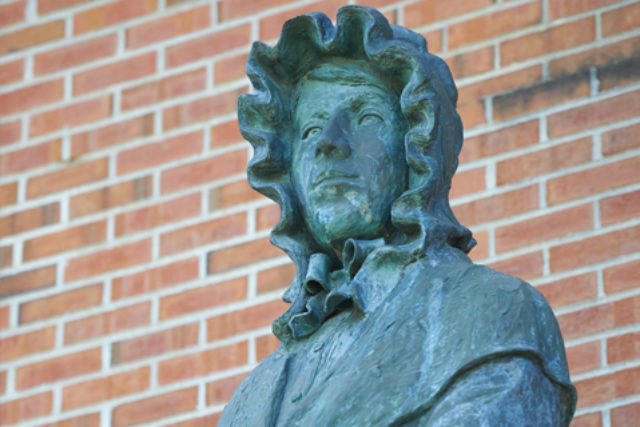About Mary Frances Clarke

Mary Frances Clarke founded a community of teachers and she directed them to “teach without seeming to teach.” When she instructed the Sisters to “incite” student-girls to think for themselves, she inspired a revolution among 19th-century young women. She wanted her followers to think outside the box. This resulted in her group, the Sisters of Charity of the Blessed Virgin Mary (BVMs), being among the first congregations of apostolic women religious established in the United States.
Mary Frances Clarke’s spirit of insurgency and ingenuity was fostered by her parents. She was born in Dublin, Ireland, on March 2, 1803, to a Quaker mother, Catherine Quartermas Clarke and a Catholic father, Cornelius Clarke. Her parents’ faith and survival tactics, learned under the oppression of the harsh penal laws imposed by the English, enabled them to instill a sense of inner freedom within Mary Frances and her siblings.
During a plague outbreak in 1828, Mary Frances and her friends witnessed the destitution of their countrymen who had been forced off the farmland into the slums of Dublin. The young women decided on a course of action that would bring hope to a desperate situation. They moved into the area and began a school for girls on North Anne Street. By educating girls, they chose a way to quickly expand literacy among the impoverished people. When the graduates became mothers they, in turn, would teach their children to read and write.
A Catholic missionary priest from Philadelphia, impressed by what he saw when he visited the North Anne Street school, convinced Mary Frances Clarke and her friends, Eliza Kelly, Margaret Mann, Rose O’Toole and Catherine Byrne to come to America. He described the miserable conditions faced by the children of Irish immigrants in Philadelphia. The discrimination they suffered denied them the opportunity for education and forced them to work in the sweatshops of the garment district at an early age.
The enterprising and courageous young women said goodbye to their families and sailed for America on July 2, 1833. Arriving in New York harbor on September 7, they experienced a loss that would make them as poverty-stricken as the people they came to serve. As Eliza Kelly, the keeper of the funds, disembarked down the swinging ladder of the sailing ship into the waiting dingy, her purse became unlatched and the women watched as all their money fell into the sea. After receiving a loan from a fellow passenger they traveled on to Philadelphia only to discover that the missionary, who promised to meet them and help establish a school, was nowhere to be found.
When Rev. Terence J. Donaghoe, a local pastor and a fellow countryman, heard of the plight of the “Dublin ladies,” he agreed to rent a building for their school. To support themselves while they taught the poor girls of the Irish immigrants, the women did piece-work for a garment factory.
Father Donaghoe strongly affirmed Mary Frances’ and her friends’ belief that education was the way to improve the lot of the immigrants. He encouraged the five women to form a pious society to strengthen their commitment and to attract others so that they might expand the work they were doing. On November 1, 1833, Mary Frances Clarke, Margaret Mann, Eliza Kelly, Rose O’Toole and Catherine Byrne pronounced private vows of poverty, chastity and obedience. This action brought into existence the Sisters of Charity of the Blessed Virgin Mary (BVMs).
Mathias Loras, bishop of Dubuque, a diocese that covered most of the upper Midwest, met the Sisters when he was traveling to Baltimore in 1843. He pleaded with them for help in his vast area. When the Sisters completed the long river passage and arrived on the banks of the little town of Dubuque on September 5, 1843, they unloaded their most precious possession, a piano. This invaluable item would be included in all the schools the Sisters established as they brought education to the families of miners, trappers and farmers along the western frontier. After Bishop Loras approved of the community as an official organization of the Church, the women made public vows in the primitive diocesan cathedral, St. Raphael.
After the Sisters began St. Mary Academy in a log cabin near the church, they realized that the girls in the rural areas needed to move in with them if they were to receive an education. The Sisters work week expanded to 24 hours-a-day, seven days-a-week, as they became both teachers and care givers. The lack of convenient transportation in the early days necessitated the establishment of girls’ boarding academies along with parish schools as the pioneers moved westward.
In Dubuque, the first school grew into St. Joseph Academy and later expanded into Mount St. Joseph (renamed Clarke University) in 1881. The graduates of nine Iowa academies founded by the BVMs shared their education with pioneer children as teachers in the country’s one-room schools. Today’s public school system was built upon their shoulders. These young women also laid the foundation for the Midwest Catholic Church when they began their families. What they learned from the Sisters, they handed on to their children.
Nearly 5,000 women over the past 170 years have entered the Sisters of Charity, BVM to carry on the spirit of Mary Frances Clarke. They have kept the commandments, followed the teachings of the Gospels and furthered the mission of the congregation by continuing to think outside the box.
Taken from “A Spirit of Insurgency and Ingenuity” by Kathryn Lawlor, BVM. This piece appeared in the Summer 2002 Clarke College OnCampus Magazine.
